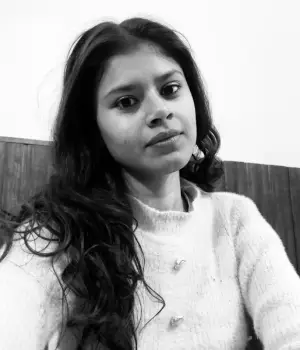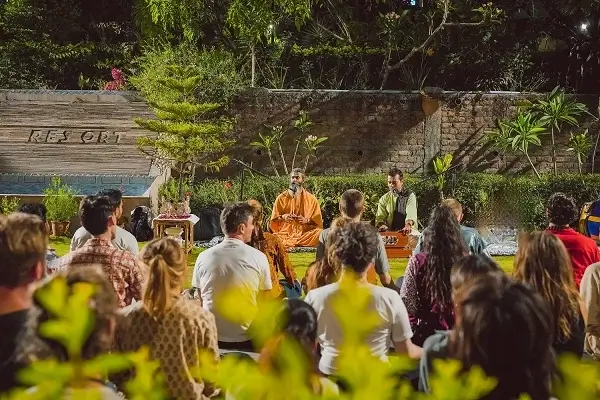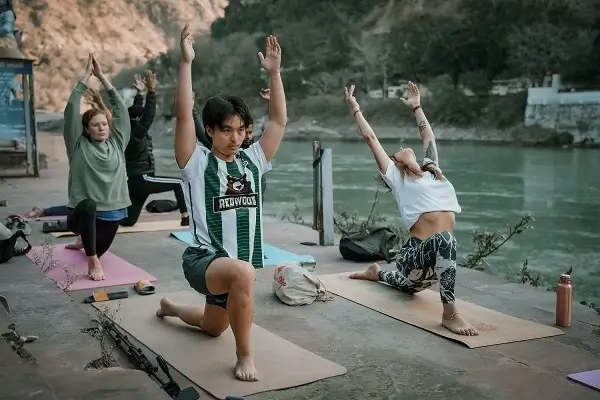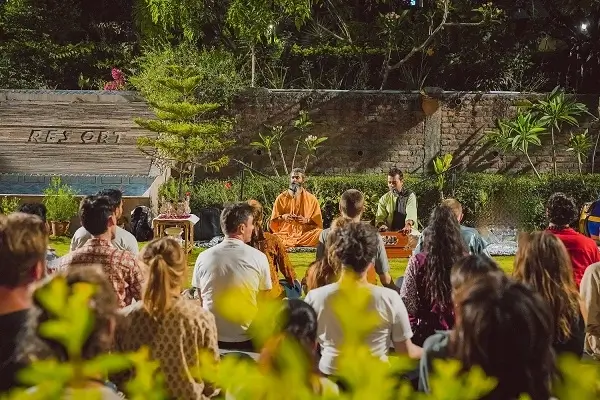11 Best Yoga Mantras For Yoga Teachers
Table of Contents
- 1. Types Of Mantra
- 2. How To Chant A Mantra
- 3. Best 11 Yoga Mantras For Class To Set Intentions
- 3.1. Shanti Mantra I
- 3.2. Ganesha Mantra
- 3.3. Shanti mantra II
- 3.4. Patanjali Mantra
- 3.5. Ashtanga Yoga Opening Mantra
- 3.6. Ashtanga Yoga Closing Mantra
- 3.7. Gayatri Mantra
- 3.8. Mahamrityunjaya Mantra
- 3.9. Shanti Mantra III
- 3.10. Guru Mantra
- 3.11. Mahamantra
It might be scary to read mantras written in Sanskrit. Consider a mantra as a tool to help you focus in your yoga practice. According to studies, incorporating mantras into practice can help to make the practice sacred and take it out of the realm of the physical and into a higher state of awareness. Every chakra is thought to have a unique vibration, which may be balanced and harmonized using specific mantras. The experience integrates music, body, and intellect in a profoundly philosophical way. Yoga mantras for yoga teachers help to dive deep into the practice of yoga and strengthen the mind-body connection.
Chanting does not need you to be in a yoga pose; it may be done before or after you get onto the mat. Chanting a mantra is a useful yoga technique for calming your mind at any time or place. One can choose a word, phrase, or invocation, and recite it aloud, silently, or even inside. Whatever works best for you. Longer mantras can be repeated up to three times, while shorter mantras should be recited 108 times to get the most benefits. Either way, set aside a few minutes to concentrate on the sound.
Types Of Mantra
Yoga mantras for yoga teachers fall into three basic categories: Nirguna (without form), Saguna (with form), and Bija (seed).
Bija Mantras
Although the Bija mantras can be employed on their own, they are most frequently combined with Saguna mantras to give them a unique potency. The primary Hindu deities and the seven chakras are associated with the Bija mantras. Example: Kreem is the beej mantra to invoke the goddess Kali.
Saguna Mantras
The Saguna mantras invite the manifestations of the individual gods. Reciting the Saguna mantras is said to transform into the true form of the respective god, therefore revealing its power. Example: Om Namo Bhagavate Vasudevaya offers an invocation to Lord Vishnu.
Nirguna Mantras
The Nirguna mantras are the earliest as they derive from the Vedic writings. These are exceedingly hard to understand and are said to have no particular shape or meaning because they do not call upon any deities. These mantras are said to encapsulate the core ideas of yogic philosophy and to identify with all of creation. It is stated that one needs a very powerful mind to focus on the abstract Nirguna mantras, hence beginners are not advised to practice them. Example: Aum, So-Ham.
How To Chant A Mantra
Three components constitute a yoga mantra for yoga teachers: meaning, vibration, and intention. Intention is the objective of your practice. Meaning is the definition of your mantra. The vibration or the sacred sound is the link to the life force that your practice generates.
Mantras can be silently chanted in the mind, muttered gently, or yelled out loud. Reciting the holy words out loud is known as Vaikhari Japa, and it helps with pronunciation, focus, and connecting with the words. Upamsu Japa is the practice of softly humming or whispering words to promote harmony. Manasika Japa is an intensely focused internal chanting, or chanting just in the mind.
Best 11 Yoga Mantras For Class To Set Intentions
It is believed that mantras serve as a bridge between the devotee and the divine because each one invokes a specific power that can be used for very specific purposes. Yoga mantras for yoga teachers can become even more powerful when combined with the practitioner’s intention.
Shanti Mantra I
Oṃ saha nāv avatu
saha nau bhunaktu
saha vīryaṃ karavāvahai
tejasvi nāv adhītam astu Mā vidviṣāvahai |
Om śāntiḥ śāntiḥ śāntiḥ ||
Meaning
“Om! May God protect us both together. May God nourish us both together.
May we work conjointly with great energy.
May our study be vigorous and effective.
May we not mutually dispute
Om! Let there be peace in me!
Let there be peace in my environment!
Let there be peace in the forces that act on me.”
Ganesha Mantra
Vakratunda mahaakaaya suryakoti samaprabhaa
Nirvighnam kurumedeva sarvakaaryeshu sarvadaa
Om Gam Ganapataye Namah
Meaning
“Salutations to the supreme Lord Ganesh, your curved trunk and massive body shine like a million suns and showers his blessings on everyone. Oh my lord of lords Ganesh, please remove all my obstacles, always and forever in all my activities and efforts.”
Shanti mantra II
Om Sarve Bhavantu Sukhinah
Sarve Santu Niraamayaah |
Sarve Bhadraanni Pashyantu
Maa Kashcid-Duhkha-Bhaag-Bhavet |
Om Shaantih Shaantih Shaantih ||
Meaning
“OM
May we all be happy
May all be free from illness
May all see what is auspicious
May no one suffer in any way
OM, peace peace, peace”
Patanjali Mantra
Yogena chittasya padena vacham
Malam sharirasya cha vaidyakena
Yopakarottam pravaram muninam
Patanjalim pranjaliranato’smi
Meaning
“He who purifies the impurities of the mind by yoga, speech by grammar
He who purifies the impurities of the body through medical science
He who is an expert in removing the impurities, to that most excellent of munis
I bow down with folded hands to sage Patanjali”
Also read: 80 Yoga Sanskrit Words Every Yoga Teacher Should Know
Ashtanga Yoga Opening Mantra
Om
Vande Gurunam Charanaravinde
Sandarshita Svatma Sukava Bodhe
Nih Shreyase Jangalikaayamaane
Samsara Haalahala Mohashantyai
Abhahu Purushakaram
Shankhacakrsi Dharinam
Sahasra Shirasam Shvetam
Pranamami Patanjalim
Meaning
“Om,
I bow to the lotus feet, of our great teachers
Who uncovers our true self and awakens happiness
Like a Shaman in the jungle, he brings complete well-being. (In ancient times, it was believed the shamans of the jungle were the best doctors)
He can even heal the most awful poison and illusion.”
“From the hand up to the head he has the shape of a human
In his hand, he is holding the conch and disc
On the top of his head, he has a thousand hoods of the cobra, because he is the incarnation of Adishesha, the greatest cobra
I bow down to Patanjali.”
Ashtanga Yoga Closing Mantra
Svasthi Praja Bhyaha Pari Pala Yantam
Nya Yena Margena Mahim Mahishaha |
Go Brahmanebhyaha Shubamastu Nityam
Lokah Samastah Sukhina Bhavantu ||
Om Shanti Shanti Shantihi
Meaning
“May the rulers of the earth keep to the path of virtue
For protecting the welfare of all generations in every way
May there be goodness for those who know the Earth to be sacred, and all peoples be forever blessed,
May all beings everywhere be happy and free
OM, peace, peace, peace”
Also read: Best Books for Yoga Teacher Training
Gayatri Mantra
Oṃ
bhūr bhuvaḥ svaḥ
tat savitur vareṇyaṃ
bhargo devasya dhīmahi
dhiyo yo naḥ pracodayāt
Meaning
“Om,
We meditate on that most adored Supreme Lord, the creator, whose divine light illumines all realms physical, mental, and spiritual.
May this divine light illumine our intellect.”
Mahamrityunjaya Mantra
Om tryambakam yajāmaheoṃ
sugandhim puṣṭivardhanam
urvā rukamiva bandhanān
mṛtyu mukṣīya mā'mṛtāt
Meaning
“Om, we worship the three-eyed one,
Whose fragrant is increasing the nourishment
From these many bondages of the world, similar to cucumbers
May I be liberated from death, so that I am not separated from the perception of immortality.”
Shanti Mantra III
Oṃ asato mā sadgamaya
tamaso mā jyotirgamaya
mṛtyormā’mṛtaṃ gamaya
oṃ śāntiḥ śāntiḥ śāntiḥ
Meaning
“Om, keep me not in unreality but make me go towards the reality
Keep me not in the darkness but make me go towards the light
Keep me not in the fear of death/mortality but make me go towards the knowledge of immortality
OM, peace, peace, peace”
Guru Mantra
Guru Brahma, Guru Vishnu, Guru devo Maheshwara,
Guru sakshat, param Brahma, tasmai shri guravay namah
Meaning
“Oh, my Guru who is the Brahma (The Creator), Guru is the Vishnu (The Preserver), Guru is the Maheshwara (Lord Shiva, The Destroyer),
With this knowledge, Guru you are the Supreme God or the Absolute Truth (as the Guru leads us to the path of divinity or light), my salutations to you Shri Guru.”
Mahamantra
Hare Krishna Hare Krishna Krishna Krishna Hare Hare
Hare Rama Hare Rama Rama Rama Hare Hare
Meaning
“O Lord, please engage me for your service”
Krishna means the ‘attractive one ’ and refers to the Supreme Person who is the origin of all that exists. The name Krishna denotes the ultimate truth, the all-pleasant, all-blissful, all-knowing divine entity made up of all the positive attributes.
Rama refers to the ‘reservoirs of pleasure’. It refers to Krishna also called Radha Raman which means beloved of Radha.
Hare is the invocation to the divine feminine as Krishna’s everlasting consort is Radha who is the epitome of heavenly love and devotion. Devotees are asking for her assistance in achieving pure love for God by repeating her name in the mantra.
Learn the Mantras in our 200-Hour Yoga Teacher Training in Rishikesh














